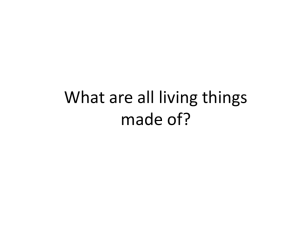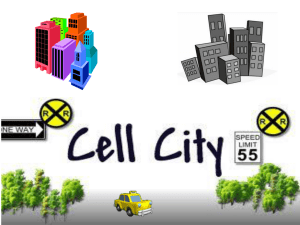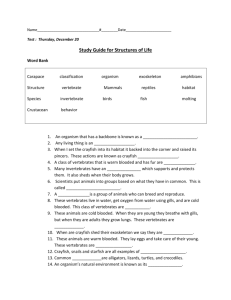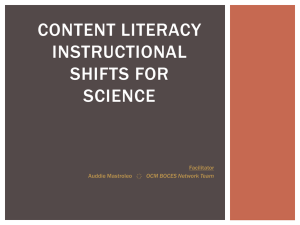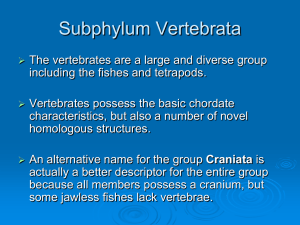Science GPS Review Grade 5
advertisement
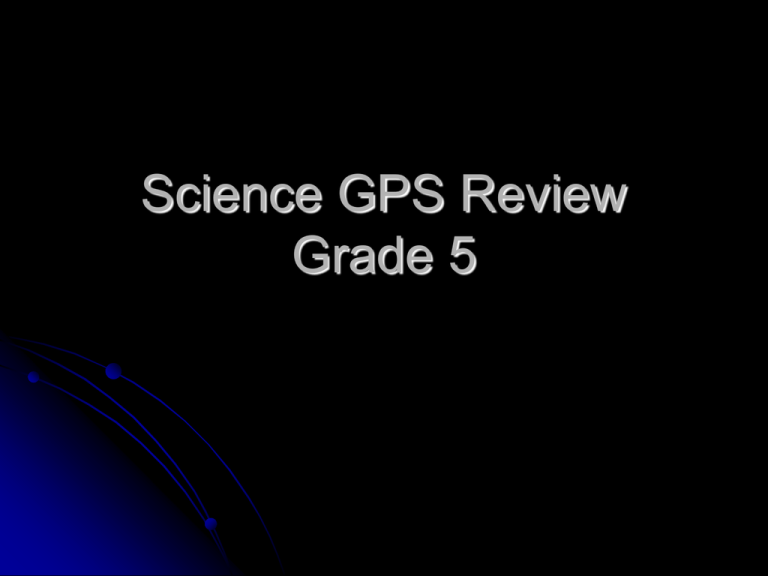
Science GPS Review Grade 5 Scientific Inquiry Problem or question Hypothesis Procedure Observations Conclusions Earth Science Earth’s surface is changed through constructive and destructive processes. If something is constructed, it is built up. If something is destructed, it is destroyed. Earth Science Deposition (deltas, sand dunes) – the dropping of sediments that have been moved from one place to another Earth Science Plate tectonics – theory that giant plates of crust are slowly moving across Earth’s surface Earth Science Earthquakes – violent shaking of the Earth’s crust as built-up energy is released Epicenter – point on Earth’s surface directly above the focus of an earthquake Earth Science Volcanoes – formed when magma breaks through the surface Earth Science Seismic Waves – waves of energy sent through Earth’s crust when parts of the crust move suddenly Faults – cracks in the Earth’s crust where movement takes Earth Science Ring of Fire – are of many earthquakes and volcanoes along the edge of the Pacific Ocean Earth Science Surface features caused by destructive processes: Erosion Weathering Impact of organisms Earthquakes Volcanoes Earth Science Erosion – carrying away of sediments by moving water, wind, or ice Erosion involves removal and transport. Earth Science Weathering – can be mechanical (rocks broken into smaller pieces called sediment) or chemical (rocks change into other materials or dissolve) Chemical weathering, takes place when at least some of the rock’s minerals are changed into different substances. Chemical processes include rain, acid etching by plants, oxidizing, and demineralizing by water. Mechanical weathering, involves physically breaking rocks into fragments without changing the chemical make-up of the minerals within them. There are four main sources of power for mechanical weathering. Gravity, Water, Wind, & Waves Of these, water appears to be the leader in changing the surface. Earth Science FLOOD CONTROL: dam – a wall across a river that controls the flow of river water Earth Science FLOOD CONTROL: levee – a wall along the banks of a river that serves to keep the water behind it Earth Science FLOOD CONTROL: storm drain – a system of pipes or channels that carry away storm water) Earth Science BEACH RECLAMATION: (Georgia coastal islands) – beach erosion is caused by dredging (deepening bodies of water), rivers changing direction, and rising ocean levels – beaches can be rebuilt through nourishment (adding more sand), building sea walls to stop erosion Earth Science BEACH RECLAMATION: Physical Science The mass of an object is equal to the sum of its parts. This clay ball has a certain mass. If I break it into pieces, the mass of the pieces will be the same as the entire ball. Physical Science Physical properties of matter: color, shape, texture, luster, density Physical Science Chemical properties of matter (can only be seen when a chemical change has happened) – air can cause rust, water, heat Physical Science Physical Changes Do not result in a new material Ex. Folding paper Ex. Water changing state (through changes in temperature) Physical Science Chemical Changes result in a new material being created. Ex. Oxidation from rusting of metal or browning of fruit Ex. Combining vinegar and baking soda to produce a gas Ex. Decaying material in a compost pile Physical Science When a chemical change occurs, there may also be: A change in temperature A gas being released A change in acidity A change in measurement A change in physical attributes (color, texture, odor) Physical Science Static electricity – electric charge built up on material Physical Science Electric current – a continuous flow of electric charges Physical Science Complete circuit – the pathway that an electric current follows Physical Science Insulators (stop electric flow) and conductors (allow electricity to flow) Physical Science Parallel circuit – more than one pathway for the electricity to follow Physical Science Series circuit – only one pathway for the electricity to follow Physical Science Bar magnets (attract some metals) and electromagnet (a strong temporary magnet) Life Science Classify organisms into five kingdoms (animal, plant, fungi, protists, bacteria) Do you know that there are FIVE Kingdoms of living things? Moneran One-celled with no membrane around the nucleus Protist Fungus Plant Animal One-celled Most are manycelled Manycelled Manycelled Life Science Animals can be sorted into groups (vertebrate and invertebrates) Vertebrates can be sorted into groups (fish, amphibian, reptile, bird, mammal) Animals Vertebrates Invertebrates Mammals Vertebrates Have body hair or fur Have mammary glands that produce milk Warm blooded Fish Vertebrates Live in water Breathe with gills Streamlined bodies Have cartilage or bony skeleton Cold blooded Mostly lay eggs Reptiles Vertebrates Have dry, scaly skins Egg laying Breathe with lungs Cold blooded Amphibians Vertebrates Moist skin Lay their eggs in water Larvae have gills and live in water Adults have lungs and live on land Cold blooded Birds Vertebrates Have feathers and wings Lay eggs with hard shells Breathe with lungs Warm blooded Animals Vertebrates Mammals Fish Invertebrates Cnidarians Flatworms True worms Reptiles Molluscs Amphibians Echinoderms Birds Arthropods Life Science Plants can be sorted into groups – Vascular (have tubes) and nonvascular (absorb water through cells angiosperms (vascular plant that produces seeds from flowers), gymnosperm (vascular plant that produces weeds, but not flowers or fruit) Life Science Parts of an animal cell (membrane, cytoplasm – jelly-like substance, nucleus – the brain) Life Science Parts of a plant cell (membrane, cell wall, cytoplasm – jelly-like substance, nucleus – the brain, chloroplasts – make food and provide green color) Functions of cell parts Life Science Functions of cell parts Compare and Contrast plant and animal cells. Animal Cells •Cell membrane •Cytoplasm •Vacuoles •Nucleus Plant Cells •Cell wall •Cell membrane •Cytoplasm •Vacuoles •Chloroplasts •Nucleus Nucleus The “brain” of the cell Controls all of the cellular activities DNA is inside the nucleus CELL MEMBRANE holds the cell together keeps all of the pieces (like the organelles and the cytoplasm) inside the cell controls what goes in and out of the cell Example: like a big plastic bag with tiny holes in it •SOLAR energy radiated from the sun is captured by plants(chloroplast) •Then it is instantaneously changed into ELECTRICAL energy •Then packaged as CHEMICAL energy Chloroplast Chloroplast •photosynthesis takes place inside the chloroplast the process in which plant use Photosynthesis- water, carbon dioxide, and energy form the sun to make food Life Science Learned behaviors (acquired traits) – table manners and habits learned from the family Life Science Inherited Traits – characteristics passed through heredity (genes (eye color, hair color, size) Life Science Genes transfer traits through DNA found in the nucleus of cells. Nucleus CHROMOSOMES- are found inside the nucleus carry the information that Chromosomes – determines what traits a living thing will have Life Science Beneficial organisms Help make foods Help make medicines Help fight diseases Help fight insects Life Science Harmful organisms May cause illness May spoil food May spoil water May damage clothing and other items



